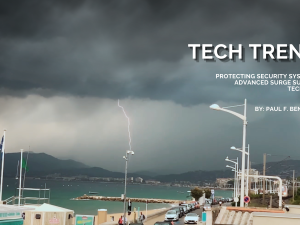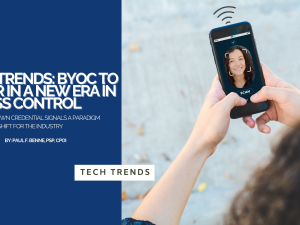In the dynamic landscape of security operations, staying ahead of potential threats is paramount. As organizations face increasingly sophisticated risks, the role of Protective Intelligence has emerged as a cornerstone in fortifying a company’s security posture.
A Security Operations Center (SOC) serves as the nerve center for monitoring, detecting, and responding to security incidents. Integrating Protective Intelligence within the SOC framework not only bolsters its efficacy, but it also empowers proactive measures against potential vulnerabilities.
Understanding Protective Intelligence
Protective Intelligence encompasses the proactive gathering, analysis, and dissemination of information to preempt and mitigate security threats. Unlike traditional reactive approaches, which respond after an incident occurs, Protective Intelligence focuses on identifying potential risks before they materialize. This proactive stance enables security teams to anticipate threats, assess vulnerabilities, and implement preemptive measures, thereby minimizing the effects of a potential event.
Fortifying the SOC with Protective Intelligence provides security teams with actionable information that was previously non-existent or difficult to come by. Today, robust platforms like samdesk (www.samdesk.io), Dataminr (www.dataminr.com), and LifeRaft (www.liferaftinc.com), are game-changers in empowering security teams with Protective Intelligence.
In an era defined by evolving cyber threats, geopolitical instability, and emerging risks, the role of Protective Intelligence in enhancing the performance of SOCs cannot be overstated. By adopting a proactive stance rooted in intelligence-driven decision-making, organizations can fortify their security program, mitigate risks, and safeguard their assets against potential threats. Here are some of the key features and benefits these platforms provide:
Early Threat Detection: One of the primary advantages of incorporating Protective Intelligence into SOC operations is the ability to detect threats at an early stage. By leveraging various sources – such as open-source intelligence, social media monitoring, and threat intelligence feeds – security analysts can identify indicators of potential threats before they escalate. This early detection enables swift intervention, preventing potential breaches or attacks.
By analyzing threat patterns and tactics, security teams can devise preemptive measures to deter potential adversaries.
Risk Assessment and Prioritization: Protective Intelligence provides valuable insights for risk assessment and prioritization within the SOC. By analyzing the credibility and severity of threats, security teams can allocate resources effectively, focusing on the most critical areas of concern. This targeted approach increases operational efficiency and ensures that the SOC remains vigilant against the most significant risks.
Enhanced Situational Awareness: Real-time intelligence feeds and threat analysis enhance the situational awareness of SOC operators. By continuously monitoring evolving threats and trends, security analysts gain a comprehensive understanding of the threat landscape. This heightened awareness enables proactive decision-making and rapid response to emerging security challenges, minimizing potential disruptions to business operations.
Threat Mitigation Strategies: Protective Intelligence enables the development of proactive threat mitigation strategies tailored to specific risks. By analyzing threat patterns and tactics, security teams can devise preemptive measures to deter potential adversaries. Whether through enhanced perimeter security, employee awareness training, or advanced threat-hunting techniques, Protective Intelligence empowers SOC operators to stay one step ahead of potential threats.
Intelligence-Led Investigations: Integrating Protective Intelligence into SOC operations facilitates intelligence-led investigations into security incidents. By correlating internal security data with external threat intelligence, analysts can uncover patterns, trends, and indicators of compromise more effectively. This intelligence-led approach streamlines incident response efforts, enabling faster containment and remediation of security breaches.
Proactive Threat Hunting: Protective Intelligence empowers SOC teams to engage in proactive threat-hunting activities. By leveraging advanced analytics and threat intelligence, analysts can proactively search for signs of malicious activity within the network. This proactive stance allows security teams to identify and neutralize threats before they cause significant harm, enhancing the efficacy of organizational defenses.
Collaborative Intelligence Sharing: Effective Protective Intelligence relies on collaboration and information sharing both within the organization and with external partners. By participating in threat intelligence sharing communities and industry forums, SOC teams can gain access to valuable insights and collective intelligence. This collaborative approach enhances the accuracy and timeliness of threat intelligence, strengthening the overall security posture of the organization.
Challenges to Avoid
While the benefits of Protective Intelligence are undeniable, implementing and managing an effective program within the SOC comes with its own set of challenges. The following considerations should be acknowledged and planned for when considering and deploying a Protective Intelligence program. This will minimize any negative or adverse effects of using this technology.
Data Overload: The sheer volume of data generated by various intelligence sources can overwhelm SOC analysts, making it challenging to separate qualified threats from noise. Narrowing the focus of the information these systems collect will help reduce the volume of inbound information that the SOC needs to review.
Resource Constraints: Building and maintaining a robust protective intelligence program requires dedicated resources, including skilled personnel, technology infrastructure, and ongoing training. To implement a Protective Intelligence program, there should be an analysis of whether current SOC staff are able to handle the additional tasks associated with accurately and efficiently curating the inbound intelligence.
Integration Complexity: Integrating disparate intelligence sources and tools into the SOC ecosystem can be complex, requiring seamless interoperability and data correlation capabilities. It is best to crawl before you run, keeping the program simple before creating multiple system dependencies.
Privacy and Compliance: Adhering to privacy regulations and compliance standards while collecting and analyzing intelligence data is critical to maintaining trust and legality. It is important to collaborate with your legal team when creating a Protective Intelligence program to play it safe.
This article originally appeared in the May 2024 issue of Security Business magazine. Paul F Benne is the President of Sentinel Consulting and has over 35 years in the protective service industry.







